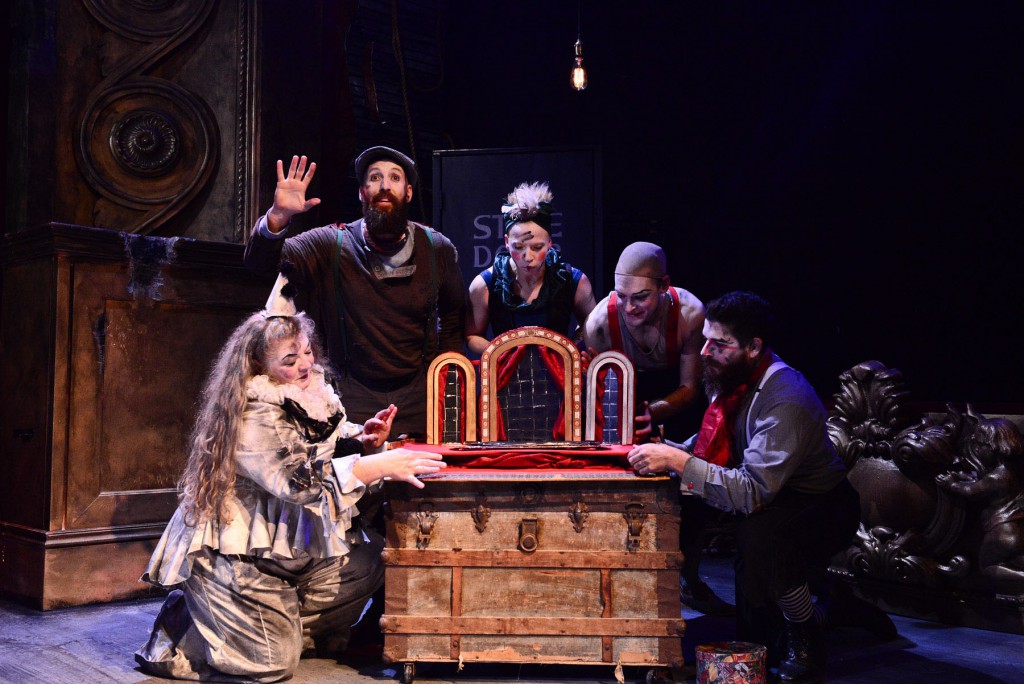By Alexandra Garfield
Heart-wrenching with a sprinkling of hope and a healthy serving of laughter, Burning Bluebeard intertwines two stories in one spine-chilling show.
Actors portraying actors from the infamous 1903 Iroquois Theater fire attempt to finish their performance of the holiday pantomime, Mr. Bluebeard. Only this time, they hope it won’t end in another tragedy.
The show is a deep narrative dive into the 1903 matinee fire, with the performers returning to finish the show amid the ruins the day after it took place. The performers explain that a spark from the artificial moonlight started the blaze. The lack of viable emergency exits, exit doors that opened inward, blocked shut as the panicked crowd packed against them, and the flammable hemp seat-cushions contributed to the deaths of more than 600 people.
“Most people just know that the doors opened in, not out, but that’s only part of the story,” said Leah Urzendowski, who plays the show’s aerialist Nellie Reed.
While explaining the fire to the audience, the six actors also try to perform the story of Bluebeard’s seven wives, reenacting the 1903 show and unintentionally circling around the theme of death.

The play is set on December 31, 1903, the day after the Iroquois Theater fire when Chicago Mayor Carter Harrison, Jr., closed all of the city’s theaters. Despite the historic setting, the show doesn’t shy away from using modern music and storytelling forms in the performance.
The actors simultaneously tell the story of the fire and the fairytale of Bluebeard’s seventh wife, the only one he didn’t kill. The action laces together personal monologues, interpretive dance numbers and hilarious renditions of modern songs. For example, Amy Winehouse’s Rehab and Europe’s The Final Countdown both make unexpected appearances in this play set at the turn of the last century.
One moment, Scandinavian electronic music accompanies a surprisingly touching interpretation of the deaths of Bluebeard’s first six wives. The next moment the actors hold jars of Christmas lights on a dark stage to explain their roles in the play the day of the fire.
Each scene uses unconventional methods to tell a 112-year-old story. The script balances between tragedy and comedy until the final scenes when you truly feel the devastation of the fire. It is impressed upon the audience that the fire was an accident. No one on stage is ever blamed – there’s no conclusive ending trying to frame a villain.
“We just wanted to give you some artificial moonlight.”
– Robert Murray, played by Jay Torrence, Burning Bluebeard
This is aided by the fact that the playwright, Jay Torrence also plays the role of the stage manager, Robert Murray. The audience sees each character do the best they can at each turn of the plot. This makes it difficult for the audience to place the blame on any individual in the play. Murray, for example, throws opens up the stage doors to save the cast, unintentionally dooming the audience when the December air fuels the flames.
Ryan Walters, playing Chicago vaudeville comedian Eddie Foy, shows true desperation when he begs the audience, “don’t panic. Please, stay in your seats.” Later the audience can see the devastation on his face at the realization that his words only added to the death toll.

However, the most touching performance comes from Leah Urzendowski, playing Nellie Reed. Reed, an aerialist in Mr. Bluebeard, was the only performer to die in the Iroquois fire.
Every detail of Urzendowski’s performance makes you believe in a young woman who wanted to fly. Her descriptions of throwing arms full of carnations to the audience in the gallery “cheap seats” make you wonder what more this woman could have accomplished with a longer life.
“You know, it’s an emotionally demanding show, but I don’t really think of it that way,” said Urzendowski. “Instead, it becomes really dire to me that this story gets told, that Nellie’s story get’s told.”
Burning Bluebeard runs through Jan. 10 at The Den Theater, 1329 N. Milwaukee Ave. Tickets: $15-$36.


